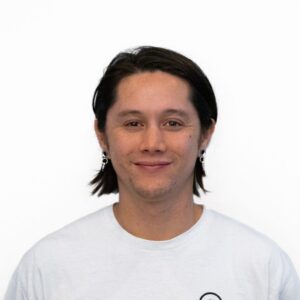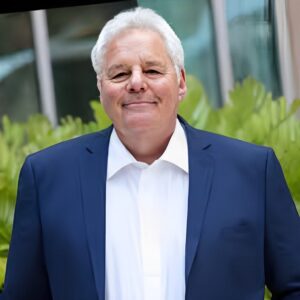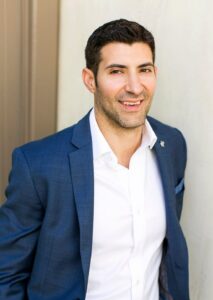The Future Is Now: Stan Farnsworth Of PulseForge On How Their Technological Innovation Will Shake Up The Tech Scene
An Interview With Fotis Georgiadis
Trust yourself, and learn to communicate your ideas. Plenty of times I’ve had ideas that weren’t “in the plan” or weren’t understood by my colleagues or managers. Yet, I knew they were important. I continue to strive to improve my communications skills, and coach students that effective communications are as important as having ideas to communicate! Having confidence in myself has been helpful throughout the years to help guide my day-to-day efforts as well as to provide an evolving longer-term narrative: From initial concept of the PulseForge tools to adoption in making cell phone displays!
As a part of our series about cutting edge technological breakthroughs, I had the pleasure of interviewing Stan Farnsworth.
Stan Farnworth, chief marketing officer of PulseForge Corp., has been bringing technology innovations to markets and applications for over 25 years, with an emphasis on pulsed light thermal processing. As one of the founding members of NovaCentrix (2008) he was instrumental in bringing world-wide acceptance of pulsed light thermal processing to markets such as consumer electronics, photovoltaics, and RFID, along with diverse technical and scientific applications. Today, an estimated 600+ million products have been produced using this technology. As a founding member of Nanotechnologies Inc (1999), an early pioneer and recognized leader in the nanomaterial space, he set product and application priorities for nanomaterials and dispersions and led deployments in applications such as conductive inks and antimicrobial wound care additives. His volunteer activities include chairing the Frankfurt-based OE-A, the leading international association for printed and large-area flexible electronics with over 230 member organizations worldwide, mentoring entrepreneurs at the Capital Factory in Austin, and chairing the STEM advisory board at an Austin area high school. In this capacity, he has been working to increase diversity in STEM education and improve awareness of technology opportunities for all students. He has a master’s in mechanical engineering from the University of Texas and a bachelor’s in mechanical engineering from Rice University.
Thank you so much for doing this with us! Can you tell us a story about what brought you to this specific career path?
Hi, it’s certainly my pleasure and honor to speak with you! My first introduction to pulsed-light processing actually happened in graduate school. My lab was attached to an Army-funded facility working on electro-thermal rail guns and hyper-velocity ballistics. A curious material residue powder was observed to be accumulating at the end of the launch-tube of the rail gun, which turned out to be very novel forms of nanoscale materials. We formed Nanotechnologies Inc to evolve and produce these very unique materials for diverse applications. Eventually those related technologies formed the basis of the innovative flash-lamp-based heating system, initially dubbed photonic curing, and which has now been spun-off into PulseForge Corp. to address global opportunities in sustainable manufacturing. At Nanotechnologies Inc., I was initially leading the technology-development efforts, but we were having a hard time finding a business team with a deep-enough understanding of both the tech and the markets. I was spending my time working with them to coach them along, and soon after the foundation the investors approached me to ask if I would consider moving over to the business side. I was intrigued by that and made the switch to the business side permanently. Today, I truly enjoy being able to stay involved in tech advancements and guide the intersection and engagement with both near-term and over-the-horizon market opportunities, while taking our innovations all the way to the market.
Can you share the most interesting story that happened to you since you began your career?
Well, how much time do we have! Working on bio-terror remediation solutions with U.S. special forces, and in general convincing any number of very skeptical engineers that our new tech was not only feasible, but actually an advantage come to mind. Specifically though, one of the more poignant experiences earlier in my career was when we made the decision to explore the effectiveness of nanosilver powders against a range of bacteria and viruses. We sponsored a set of testing that demonstrated impressive antimicrobial and anti-viral results, even obtaining some very cool electron microscope images of the nanosilver interacting with bacteria and viruses. The FDA got wind of this and invited me to travel to Bethesda to present our findings to a special open attendance session. As a mechanical engineer the thought of presenting our bio-efficacy findings to leading global experts was very intimidating! In the end the session went very well. At the same time, we had started the EPA application process to register our nanosilver as an active ingredient for various sanitation and disinfecting products, based on the same data. We were told that these introductory meetings were often perfunctory, with one or two EPA attendees usually. To the contrary, I walked in on a full room, with maybe 2 dozen senior EPA scientists and administrators, including an assistant director of the whole EPA. We had a very helpful exchange, and that wound up playing a large role in how we decided to go forward.
Can you tell us about the cutting edge technological breakthroughs that you are working on? How do you think that will help people?
Our focus now is on the PulseForge® Digital Thermal Processing™ tools. These tools deliver energy unlike any tools in the global manufacturing industry, and in fact, are a new means of delivering applied energy for manufacturing. They allow designers to build what they imagine, resolving the limitations of materials and processing temperatures on product design and manufacturing. Essentially, they allow very high-temperatures to be achieved with temperature-sensitive materials for brief moments of time, allowing the benefits of high-temp processing without damaging the low-temp materials. For example, the PulseForge tools can solder electronic components and batteries, actually melting the metallic solder, directly onto thin lightweight flexible plastic. It seems impossible, but works because of how we are using time and physics in our favor. Not only that, because of the sub-second processing times, energy savings of as much as 85% are achieved. This in turn means significant greenhouse gas emission reductions and will meaningfully decarbonize the supply chain. We ran some estimates and broader adoption of these tools could single-handedly drop global greenhouse gas emissions by 1% or greater in the next 10 years.
So what does all this mean for real-world products? Well, for example it means blood testing and other forms of more advanced medical wearables can be built directly on skin patches, and not on detached test probes or cumbersome chunky designs. The benefits include more accurate, real-time monitoring of health conditions resulting in substantial lifestyle improvements and reduced health disruptions. Our technology also enables new light-weight versions of AR/VR goggles that look and feel more like eye masks than the awkward strap-on plastic boxes. It turns out that currently around 20 minutes is the rule of thumb for average consumer tolerance of wearing AR/VR googles. Making the goggles lighter and more comfortable dramatically increases user tolerance, which in turn increases the opportunities for content and games enriching the user experience.
How do you think this might change the world?
We envision a world with new products currently unimaginable, built to provide improved health and lifestyle while at the same time being smarter and more responsible to the health of the planet and all those who live here. By offering designers and producers new manufacturing technologies, we can let them better tap into their creativity without being hampered by current manufacturing constraints.
We chose to debut PulseForge Corp. at CES in Las Vegas a few weeks ago exactly because we could engage with product designers seeking to reduce weight and increase form-factor flexibility by being able to build electronics on new materials like lightweight recycled plastic, paper, or textiles. As wearables, AR/VR, and automotive markets continue to evolve, along with consumer expectations for performance and sustainability, our technology is proving key to enabling these to collectively be achieved, without compromise. It’s extremely important to us that we evolve with the industry and provide earth-friendly solutions to the global market. By combining increased performance and design flexibility, plus manufacturing efficiency and throughput, with dramatic energy savings, and at equipment pricing similar to or reduced from current solutions, we will make the earth-friendly choice the right choice by any consideration. This will change how businesses and brands operate, and empower consumers to make earth-friendly purchase choices.
Keeping “Black Mirror” in mind, can you see any potential drawbacks about this technology that people should think more deeply about?
To some degree, our current global situation of pollution and strained natural resources is the result of not taking into account the earth impact of technology adoption up to now. I was actually heavily influenced by Ray Bradbury as a boy, reading the Martian Chronicles anthology many times. I was horrified at the prospect of having to live underground or in protective bubble cities due to wanton disregard for the planet’s natural resources and ecosystems, including the stunning bio-diversity Earth enjoys. With the PulseForge tools we are trying to tip the scales back into equilibrium, facilitating the next level of technology development and adoption and enabling responsible stewardship of this great planet and all life on it.
Was there a “tipping point” that led you to this breakthrough? Can you tell us that story?
For this I must credit our team including Dr. Kurt Schroder. He first realized we could take a derivative of the rail gun technology we had been using to make nanoparticles, and pivot that into powering novel flash lamps to achieve this type of near-instant thermal processing, thereby shortcutting the collateral damage that is typically the result of high-temp processing. Once this technology was refined and productized, our first major implementation was in the production of cell phone displays in the mid 2010’s. Our tools enabled the use of new materials that the product designers needed in order to achieve very aggressive design and performance requirements. To have been with the tech from concept all the way to global mainstream utilization is very rewarding I must say. Today millions of people own some piece of electronics that would not have been possible were it not for the use of our tools, all the while using materials and energy more efficiently.
What do you need to lead this technology to widespread adoption?
In this case we actually have to think social media. I have learned that presenting at conferences and making 1-on-1 presentations can certainly be very effective at bringing awareness of these important capabilities to those who will use them, but those methods are difficult to scale. In the relatively recent rise of social media in B2B use, we are seeing finally a scalable pathway to broader global awareness. Now we are being contacted daily by people who we have never met but who are already understanding the application and even urgency of using this new tech. These are exciting times — being able to build a global community through digital communications! Of course, person-to-person communication is still ultimately crucial, and we will continue to be very active at events and with building long-term personal relationships.
What have you been doing to publicize this idea? Have you been using any innovative marketing strategies?
I would like to think we are also in the process of pioneering how to use social media to build awareness. For example, the team trialed a new technique at CES recently. We met several potential users of the Digital Thermal Processing tools and discussed with them how these capabilities might impact their products and sustainability goals. With their permission and engagement, we recorded the conversations and have been releasing clips on LinkedIn and Twitter. The views and responses have been great! I’m a believer that use of social media platforms will continue to evolve, and we hope to stay as pioneers in being smarter in how we use these platforms for business and for bringing awareness to the ideals which are important for the team here at PulseForge Corp.
None of us are able to achieve success without some help along the way. Is there a particular person who you are grateful towards who helped get you to where you are? Can you share a story about that?
There have been so many who have shown confidence in me and given me the opportunity to grow and move forward. I’ll go all the way back to my undergraduate days at Rice University, which of course is in Houston. I was looking for a summer job back home in Austin, and was contacting research professors at the University of Texas inquiring if they needed any summer help for their programs. Most just never got back to me, and a few even responded that they had their own students and why would they want me when I didn’t even go to UT. After a few weeks though I did hear back from one professor, Dr. Dennis Wilson in the mechanical engineering department, that he got some last minute funding for a quick-turn program, but all of his students were already working on other projects. He asked if I would I be interested in putting together a start-to-finish project to develop, test, and write-up a heating study looking at different types of nose-cone shapes in the university’s high-speed (Mach 5) wind tunnel. It was a dream project, especially as an undergraduate student, and resulted in his inviting me to join his graduate school group in thermal fluids. Later, we reconnected again to start up Nanotechnologies, Inc.
Another important story for me occurred in the early days right out of grad school. I was in the manufacturing quality group at Applied Materials, and we were in the process of bringing the new Austin facility on-line as a manufacturing expansion from the HQ in Santa Clara. The transition of new semiconductor manufacturing equipment from R&D in California to be built in Austin was proving a little bit rocky. From my perspective I could see some hand-off processes and areas that weren’t lining up too well, and in my spare time started to scribble some process flow diagrams that I thought might help. I showed my manager, Alan Fogle, just so he would know I wasn’t just idly doodling, and he took note. A few days later he approached me with some urgency, asking me to gather up my sketches made on taped-together printer sheets. The Global VP of Quality was in town and wanted to see what I was doing. We met Malcolm Grey in the wood-paneled executive conference room and I spread out my pen and pencil sheets on the polished wooden table. I went over my thoughts and notes with him and the next week I was on a plane for Santa Clara. He had lined up introductions with executives and directors up and down the business units. Alan Fogle’s and then Malcolm Grey’s confidence in me and recognition of my ideas were a key factors for my success, and I like to think helped Applied Materials as well.
How have you used your success to bring goodness to the world?
Well, I hope that this story is still continuing! One example is the nanosilver I mentioned earlier. That material is being used right now in wound-care dressings that offer accelerated healing for large-area skin damage such as from burns or diabetic ulcers. The nanosilver-containing bandages are shown to promote skin regrowth and reduce infection. Also on the materials-side, I’m especially excited about one of our customers called InkSpace Imaging. They recently received FDA approval for their novel medical MRI imaging vest technology, which uses our conductive inks to build light-weight imaging vests as a tremendous improvement over the current vests which are very heavy and awkward. This has proven especially beneficial for children, who are often quite scared of the MRI process anyway plus then having to be virtually pinned down with heavy vests. The new vests are light-weight and even provide better results because they can achieve better conformal fit.
Changing products, our PulseForge customers are using our tools now for developing evolved wearables including for advanced medical monitoring. The tools are also being used to build improved solar cells, and for improved manufacturing of a number of consumer electronics products.
What are your “5 Things I Wish Someone Told Me Before I Started” and why.
- Trust yourself, and learn to communicate your ideas. Plenty of times I’ve had ideas that weren’t “in the plan” or weren’t understood by my colleagues or managers. Yet, I knew they were important. I continue to strive to improve my communications skills, and coach students that effective communications are as important as having ideas to communicate! Having confidence in myself has been helpful throughout the years to help guide my day-to-day efforts as well as to provide an evolving longer-term narrative: From initial concept of the PulseForge tools to adoption in making cell phone displays!
- Be patient — play the long game. Real change can take time, and happens one step at a time. Whether changing product development processes, or building awareness for new climate-saving industrial thermal processing technology, it takes time and diligence to have a long-term impact. Setbacks happen, but persistence and adaptation will persevere. In fact, it always takes longer to accomplish a change than it seems. Change implementation has lots of dependencies, and they are never all controllable!
- Build a team, and be open to input! Change doesn’t happen on our own. I truly love working with people, and both sharing vision and also building consensus and ownership about how to go forward is crucial. Our marketing efforts are based on the strength of relationships, with shared goals and convictions. Building advocates outside of our organization is crucial. We can’t be in every meeting our potential customers and partners have. Yet, in building external advocates, we increase the chances of our efforts being discussed. This is how we can scale our efforts.
- Stay alert. The world is always changing, and needs and opportunities will change as well. Ideas can gain and lose significance, and it’s important to evaluate the timing as well as the effectiveness of possible next steps. We have been working with PulseForge technology now for over 15 years. Yet, only recently did we realize the tremendous energy savings inherent to the tool’s concept is important! Applying the concept to other industries beyond electronics development and manufacturing is now a goal for us, with substantial implications for the size of our business as well as the health of the planet and its occupants.
- Accept help, and don’t be afraid to ask for it. Getting help is not a sign of weakness. It is a sign of awareness! Whether the help is to overcome a short-term obstacle, or to achieve a long-term vision, few great changes can happen on our own.
You are a person of great influence. If you could inspire a movement that would bring the most amount of good to the most amount of people, what would that be? You never know what your idea can trigger. 🙂
I would start a movement to encourage initiative, and to encourage rewarding initiative with opportunity. We could perhaps call the movement “The Initiative Project” and bring awareness to the ideals of individual courage it takes to try something new, to extend beyond one’s current capabilities. Entrepreneurs know this feeling well, and it can be applied in other forms and efforts. Another ideal of The Initiative Project would be to recognize and reward initiative when it is demonstrated. That’s really how we will all make progress and continue to pull forward. This can be implemented in the workplace, in volunteer work, and even in our own daily interactions with one another.
Can you please give us your favorite “Life Lesson Quote”? Can you share how that was relevant to you in your life?
One of the most important life lesson quotes would have to be “To thine own self be true.” Now, this can unpack in lots of ways. First, it does NOT mean “be a self-centered jerk”. It does not mean prioritize myself over all others. It does not mean my needs and wants are always the most important. What it DOES mean is to be aware of myself, recognizing myself for who I am, and trying to be honest about it. It is about self-awareness. This has been very helpful for understanding how I am similar, and different, from others around me and in the world at large. It has helped me to recognize strengths and weaknesses. The world can be a very confusing place, and if we spend our time trying to define ourselves based on those around us, we can be left unfulfilled and even be led astray from what is really important to us. For me this has meant being comfortable and embracing the natural curiosity I have, not being afraid to ask questions, and being truly interested in the people around me. I think it is always better to be authentic- plus it must be easier than trying to maintain some sort of façade!
Some very well known VCs read this column. If you had 60 seconds to make a pitch to a VC, what would you say? He or she might just see this if we tag them 🙂
Our PulseForge tools offer a no-compromise solution to enable manufacturing of advanced product concepts such as in VR/AR/XR, wearables, and automotive electronics, all while using dramatically less energy with resulting reduction of greenhouse gas (GHG) production. While electronics manufacturing is our current go-to-market target, our strategy is to adapt the Digital Thermal Processing concept to other areas of manufacturing, still predicated on faster production of innovative products, creating and growing market value while saving the planet at the same time. Not only that, because of the sub-second processing times, energy savings of as much as 85% are achieved. This in turn means significant greenhouse gas emission reductions, and will meaningfully decarbonize the supply chain. We ran some estimates and broader adoption of these tools could single-handedly drop global greenhouse gas emissions by 1% or greater in the next 10 years. We feel real urgency to move quickly, and those investors who share our vision for enabled products and reduced GHG should join with us to move forward with purpose and acceleration.
How can our readers follow you on social media?
You can follow us on LinkedIn at PulseForge Corporation and on Twitter at @PulseForgeCorp.
Thank you so much for joining us. This was very inspirational.
The Future Is Now: Stan Farnsworth Of PulseForge On How Their Technological Innovation Will Shake… was originally published in Authority Magazine on Medium, where people are continuing the conversation by highlighting and responding to this story.



